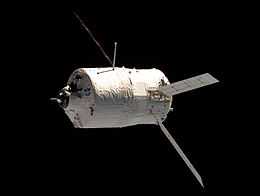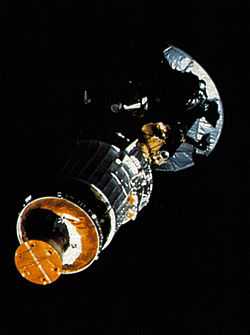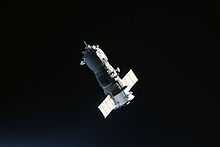Unmanned spacecraft



Unmanned spacecraft are spacecraft without people ("man") on board, used for unmanned spaceflight. Unmanned spacecraft may have varying levels of autonomy from human input, they may be remote controlled, remote guided or even autonomous ("robotic"). Many habitable spacecraft also have varying levels of robotic features. For example the space stations Salyut 7 and Mir, and the ISS module Zarya were capable of unmanned remote guided station-keeping, and docking maneuvers with both resupply craft and new modules. The most common unmanned spacecraft categories are robotic spacecraft, unmanned resupply spacecraft, space probes and space observatories. Not every unmanned spacecraft is a robotic spacecraft, for example a reflector ball is a non-robotic unmanned spacecraft.
Examples
For a more detailed list see List of Solar System probes.
Selected Lunar probes
- Luna program — USSR Lunar exploration (1959–1976).
- Ranger program — US Lunar hard-landing probes (1961–1965).
- Zond program — USSR Lunar exploration (1964–1970).
- Surveyor program — US Lunar soft-landing probe (1966–1968).
- Lunar Orbiter program — US Lunar orbital (1966–1967).
- Lunokhod program — USSR Lunar Rover probes (1970–1973).
- Muses-A mission (Hiten and Hagoromo) — Japanese Lunar orbital and hard-landing probes (1990–1993).
- Clementine — US Lunar orbital (1998).
- Lunar Prospector — US Lunar orbital (1998–1999).
- Smart 1 — European Lunar orbital (2003).
- SELENE — Japanese lunar orbiter (2007).
- Chang'e 1 — Chinese lunar orbiter (2007).
- Chandrayaan 1 — Indian lunar orbiter (2008).
- Lunar Reconnaissance Orbiter — US Lunar orbiter (2009).
- LCROSS — US Lunar hard-landing probe (2009).
- Chang'e 2 — Chinese lunar orbiter (2010).
- Gravity Recovery and Interior Laboratory — US Lunar orbiters (2011)
Mars probes
- Zond program — failed USSR flyby probe
- Mars probe program — USSR orbiters and landers
- Viking program — Two NASA orbiters and landers (1974)
- Phobos program — Failed USSR orbiters and Phobos landers
- Mars Pathfinder — NASA lander and rover (1997)
- Mars Surveyor '98 program (Mars Climate Orbiter and Mars Polar Lander) — Failed NASA probes
- Mars Global Surveyor - NASA orbiter
- Mars Odyssey — NASA orbiter, reached Mars on October 24, 2001
- Mars Observer — failed NASA Mars orbiter
- Mars Express (Mars Express Orbiter and Beagle 2) — European orbiter and failed lander 2003
- Mars Exploration Rovers — NASA rovers (2004)
- Mars Reconnaissance Orbiter — NASA orbiter, entered Martian orbit March 10, 2006
- Phoenix — NASA lander, landed May 25, 2008
- Mars Science Laboratory — NASA rover, launched November 26, 2011
Venus probes
- Venera program — USSR Venus orbiter and lander (1961–1984)
- Pioneer Venus project — US Venus orbiter and entry probes(1978)
- Vega program — USSR mission to Venus and Comet Halley (1984)
- Magellan probe — US Venus orbiter (1989)
- Venus Express — ESA probe sent for the observation of the Venus's weather (2005)
- MESSENGER - US Fly-by/Orbiter (2004)
Gas giant probes
- Pioneer program — US Jupiter and Saturn flybys
- Voyager program — US Jupiter, Saturn, Uranus and Neptune flyby and study of interstellar medium
- Galileo probe — US Jupiter orbiter and atmosphere probe (ended 2003)
- Cassini-Huygens — US-European Saturn orbiter and Titan lander Huygens (1997–present)
Comet and asteroid probes

- International Cometary Explorer — passed through gas tail of comet 21P/Giacobini-Zinner (1985)
- Giotto mission — European — flyby of comet 1P/Halley (1986)
- Vega 1 & 2 — USSR — flyby of comet 1P/Halley (1986)
- Sakigake probe — Japanese — flyby of comet 1P/Halley (1986)
- Suisei probe — Japanese — flyby of comet 1P/Halley (1986)
- NEAR Shoemaker — US — asteroid 433 Eros orbiter, which later landed on the asteroid's surface, launched 1996
- Deep Space 1 — US — comet 19P/Borrelly and asteroid flyby, 1998–2000
- Stardust probe — US — comet 81P/Wild flyby and sample return, launched 1999, flied-by 2004, returned January 15, 2006
- CONTOUR — US — comet flyby mission (comets 2P, 73P and 6P); lost due to solid rocket motor failure shortly after launch in 2002
- Hayabusa — Japanese — asteroid orbiter, lander and sample return, launched 2003, returned June 13, 2010
- Rosetta — European — comet 67P/Churyumov-Gerasimenko orbiter and lander (Philae); launched 2004
- Deep Impact — successful US comet 9P/Tempel impactor, launched 2005
- Deep Impact/EPOXI — US — comet 103P/Hartley flyby (extended Deep Impact mission) — 2010
- Stardust/NExT — US — comet 9P/Tempel flyby (extended Stardust mission) — 2011
- Dawn — US launched on September 27, 2007 — now orbiting Vesta in 2011, and intended to orbit Ceres by 2015.
Solar observation probes
- Ulysses — Solar particles and fields (ended 2009)
- Genesis — First solar wind sample return mission, 2001–2004 (crash)
- Interstellar Boundary Explorer (IBEX) — launched October 19, 2008.
- Advanced Composition Explorer — Solar particles and fields observation at Earth-Sun L1 point
- STEREO — Pair of probes in solar orbits providing 3D observations of Sun
- SOHO — Solar and Heliospheric Observatory, Observer for Sun's corona and core located at L1 point
Other Solar System probes
- Zond program — USSR flyby missions to the Moon, Venus, and Mars
- Mariner program — US Mercury, Venus and Mars flybys
- MESSENGER — US Mercury orbiter, launched 2004
- New Horizons — US launched on January 19, 2006 — First probe to visit Pluto (in July 2015)—